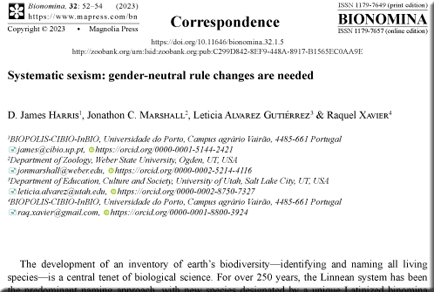Abstract
The development of an inventory of earth’s biodiversity—identifying and naming all living species—is a central tenet of biological science. For over 250 years, the Linnean system has been the predominant naming approach, with new species designated by a unique Latinized binomina following rules laid out by the International Code of Zoological Nomenclature (Anonymous 1999; “the Code” below) for animal taxa, while the International Code of Nomenclature for algae, fungi and plants (Turland et al. 2018) is the set of rules dealing with formal botanical names.
References
- Anonymous [International Commission on Zoological Nomenclature] (1999) International code of zoological nomenclature. ‘Fourth edition’. London (International Trust for zoological Nomenclature): i‒xxix + 1‒306.
- Baeckens, S., Blomberg, S. P. & Shine, R. (2020) Inclusive science: ditch insensitive terminology. Nature, 580: 185. <https://doi.org/10.1038/d41586-020-01034-z>.
- Böhme, W. & Köhler, J. (2004) Do endings of adjective flectible species names affect stability? A final note on the gender of Podarcis Wagler, 1830 (Reptilia, Lacertidae). Bonner zoologische Beiträge, 53: 293‒295.
- Caramaschi, U. (2004) The gender of the genus Scinax Wagler, 1830 (Anura, Hylidae). Herpetological Review, 35 (1): 27‒31.
- Ceríaco, L. M. P., Aescht, E., Ahyong, S. T., Ballerio, A., Bouchard, P., Bourgoin, T., Dmitriev, D., Evenhuis, N., Grygier, M. J., Harvey, M. S., Kottelat, M., Kluge, N., Krell, F.-T., Kojima, J.-I., Kullander, S. O., Lucinda, P., Lyal, C. H. C., Pyle, R. L., Reheindt, F. E., Scioscia, C. L., Welter-Schultes, F., Whitmore, D., Yanega, D., Zhang, Z.-Q., Zhou, H.-Z. & Pape, T. (2023) Renaming taxa on ethical grounds threatens nomenclatural stability and scientific communication: communication from the International Commission on Zoological Nomenclature. Zoological Journal of the Linnean Society, 197 (2): 283‒286. <https://doi.org/10.1093/zoolinnean/zlac107>.
- Dubois, A. (2011) The International Code of Zoological Nomenclature must be drastically improved before it is too late. Bionomina, 2: 1‒104. <https://doi.org/10.11646/bionomina.2.1.1>.
- Dubois, A., Aneesh, P. T., Bauer, A. M., Ceríaco, L. M. P., Daniel, G. M., Frétey, T., Löbl, I., Lorvelec, O., Marinov, M., Ohler, A., Schmitt, M., Whittington, A. & Aescht, E. (2022a) The Linz Zoocode project. Second report of activity (2020). Nomenclatural availability. 1. What is nomenclatural availability? Bionomina, 28: 1‒17. <https://doi.org/10.11646/bionomina.28.1.1>.
- Dubois, A., Aneesh, P. T., Bauer, A. M., Ceríaco, L. M. P., De Prins, J., Frétey, T., Löbl, I., Lorvelec, O., Marinov, M., Ohler, A., Schmitt, M., Whittington, A., Young, M & Aescht, E. (2022b) The Linz Zoocode project. Fifth report of activities (2022). Nomenclatural availability. 4. Electronic publication. Bionomina, 28: 71–119. <https://doi.org/10.11 646/bionomina.28.1.4>.
- Dubois, A., Bauer, A. M., Ceríaco, L. M. P., Dusoulier, F., Frétey, T., Löbl, I., Lorvelec, O., Ohler, A., Stopiglia, R. & Aescht, E. (2019) The Linz Zoocode project: a set of new proposals regarding the terminology, the Principles and Rules of zoological nomenclature. First report of activities (2014‒2019). Bionomina, 17: 1‒111. <https://doi.org/10.11 646/bionomina.17.1.1>.
- Gillman, L. N. & Wright, S. D. (2020) Restoring indigenous names in taxonomy. Communications Biology, 3 (609): 1‒3. <https://doi.org/10.1038/s42003-020-01344-y>.
- Kricheli-Katz, T. & Regev, T. (2021) The effect of language on performance: do gendered languages fail women in maths? NPJ Science of Learning, 6: 1–7. <https://doi.org/10.1038/s41539-021-00087-7>.
- Likis, F. E. (2021) Inclusive language promotes equity: The power of words. Journal of Midwifery & Women’s Health, 66: 7–9. <https://doi.org/10.1111/jmwh.13225>.
- Palma, R. L. & Heath, A. C. G. (2021) Science versus vernacular: should some taxa of animals and plants be renamed according to ‘indigenous’ practices? Bionomina, 22: 1‒7. <https://doi.org/10.11646/bionomina.22.1.1>.
- Poulin, R., McDougall, C. & Presswell, B. (2022) What’s in a name? Taxonomic and gender biases in the etymology of new species names. Proceedings of the royal Society of London, (B), 289 [2021.2708]: 1‒10. <https://doi.org/10.1098/rspb.2021.2708>.
- Rummy, P., & Rummy, J. T. (2021) Recontextualising the style of naming in nomenclature. Humanities and social Sciences Communications, 8 (1): 1‒6. <https://doi.org/10.1057/s41599-021-00975-8>.
- Salvador, R. B., Cavallari, D. C., Rands, D., & Tomotani, B. M. (2022) Publication practice in taxonomy: global inequalities and potential bias against negative results. PloS One, 17 (6) [e0269246]: 1‒18. <https://doi.org/10.1371/journal.pone.0269246>.
- Turland, N. J., Wiersema, J. H., Barrie, F. R., Greuter, W., Hawksworth, D. L., Herendeen, P. S., Knapp, S., Kusber, W.-H., Li, D.-Z., Marhold, K., May, T. W., McNeill, J., Monro, A. M., Prado, J., Price, M. J. & Smith, G. F. (ed.) (2018) International code of nomenclature for algae, fungi, and plants (Shenzhen Code) adopted by the Nineteenth International Botanical Congress Shenzhen, China, July 2017. Glashütten (Koeltz Botanical Books), Regnum vegetabile, 159: 1‒159. <https://doi.org/10.12705/Code.2018>.
- Uetz, P. & Stylanou, A. (2018) The original descriptions of reptiles and their subspecies. Zootaxa, 4375: 257–264. <https://doi.org/10.11646/zootaxa.4375.2.5>.


